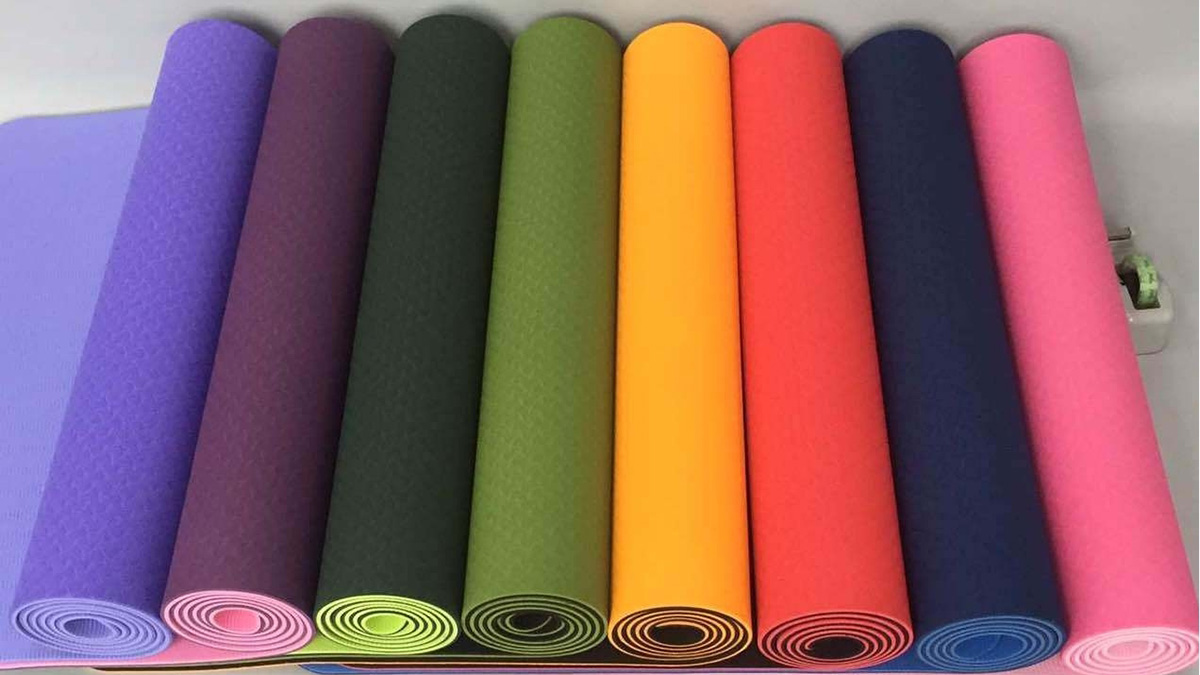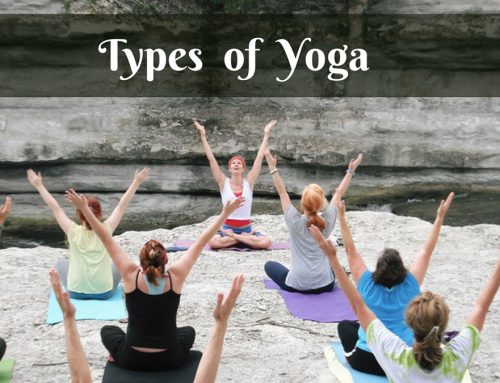There are many yoga mats made by different materials in the yoga mat market. Some mats are cheap due to the inferior material while others may be extremely expensive as they are made by premium and eco-friendly material. It is then a must for us to know the materials adopted in the manufacturing of yoga mats so that we can avoid purchasing yoga mats of deleterious materials. So, what are yoga mats made of?
- PVC
PVC materials have been applied to the production of yoga mats in bulk for years. Yoga mats made by this material are not so expensive, and have outstanding elasticity and durability. However, PVC yoga mats are NOT non-toxic ones. Following Speck, and we will show you the evidences.
What is PVC? The full name of PVC is polyvinyl chloride. It is a kind of chloropolymers that ranks third (following polyethylene and polypropylene) in the largest-selling commodity thermoplastic all over the world. It has been well-documented that there are over 40 million tons of polyvinyl chloride produced annually.
Believe it or not, all PVC materials adopt functional additives including heat stabilizers and lubricants, and add plasticizers to achieve the flexibility of your yoga mats. Heat stabilizers, as the name has implied, protect PVC from decomposing by heat. Actually, heat stabilizers are capable of minimizing the environmental effects resulted from mechanical degradation, ultraviolet light and heat during the production of PVC material and its daily use. At present, the most commonly seen heat stabilizers adopted in the manufacturing of PVC yoga mats include antimony, organochlorines and organotin compounds (sometimes lead compounds and cadmium are also contained). So let’s see whether these three major stabilizers are beneficial to our health.
Antimony in PVC mainly intensifies chlorine’s flame-retardant effect. However, in 1990, antimony and its oxide were officially added to the list of carcinogenic chemicals by the state of California. And scientists also concluded that this deleterious ingredient was one of the culprits of causing cancers and worker-related illnesses (occupational exposure). In addition, the European Chemicals Agency (ECHA) released a study pointing out that antimony might result in the worn-out organs and the fertility of the unborn infants of women in pregnancy.
Organochlorines have also be studied by scientists who propose that cancers such as gastric cancer and disruption of endocrine are closely related to organochlorines. Apart from enhancing chlorine’s flame-retardant effect (just like antimony does), organochlorines can also upgrade the impact strength of PVC. This chemical ingredient is basically a synthetic pollutant for human beings. However, the strong and practical usage as well as its compatibility makes organochlorines a suitable material for making powerful PVC.
Organotin compounds, another stabilizer adopted in the manufacturing of PVC, mainly consist of tributyltin (TBT), mono-butyltin (MBT) and dibutyltin (DBT). All these three were proved to be toxic ingredients for human body, imposing negative impact on our cells. What’s worse, even when they are at low concentrations, these chemical synthetics still present highly toxic effects.
Although the above statements of PVC are worrisome and supportive enough, Speck continues to reveal more truths of PVC for you.
When you are practicing yoga on a PVC yoga mat, it is quite normal for you to lie on the mat when you are drained by nailing asanas, which actually offers an opportunity for heavy metals to enter your body either through inhalation or skin contact. These heavy metals do great harm to your lungs, heart and blood vessels. As mentioned above, some PVC yoga mats may contain lead compounds and cadmium, the two harmful ingredients that have been classified by The International Agency for Research on Cancer (IARS) as carcinogen. Worse still, these potentially lethal heavy metals will be transferred to the infant by maternal blood and breast milk. In other words, if you are affected by heavy metals, you will also directly pose a threat to your loved kids.
Lubricants and plasticizers are also to be blamed. Lubricants can be classified into two types when it comes to the production of PVC yoga mats: the external lubricants are indispensable for reducing traction between the processing equipment and the material, while the internal lubricants are added inside of PVC. The internal ones contain heavy metals such as lead and cadmium and are therefore detrimental to human body.
Plasticizers help PVC yoga mats to be resilient and flexible. The most frequently adopted plasticizers are phthalates. Yes, phthalates! Although some yoga mat brands may claim that their yoga mats do not contain phthalates, you can not test the presence of them by yourself, right? Since 2012, government of the United States has enacted a new law to limit the adoption of some extremely toxic phthalates in kids’ products such as toys and drinkware. It has been well-proved that plasticizers like phthalates are also resulting in asthma, cancer and birth defects. You may wonder that “what if I just bought a PVC yoga mat without phthalates?” In reality, yoga mat manufacturers will use other plasticizers such as trimellitates, sebacates and adipates in place of phthalates. Compared to phthalates, these plasticizers are not so deadly yet still do harm to your health.
The last disadvantage of PVC material lies in its generation of dioxins. According to the WHO, dioxins have been tested as one of the most carcinogenic organic compounds in nature. So how does PVC produces this toxic compounds? Because PVC is a kind of material that can not be decomposed by nature, the only approach to handle with it is to incinerate it. But, when PVC material is burning, the chlorine in PVC will generate carcinogenic dioxins, which gradually accumulate in soil and water and transfer to the food chains. If you bought a fish living in the environment that has been poisoned by dioxins and later you ate it, the terrible chemicals then transfer to your body, retain and concentrate in there, damaging your immune system stealthily.
After reading the above knowledge of PVC material, Speck believes that you will make the right decision when choosing yoga mats. PVC yoga mats are NOT non-toxic ones. So what about other materials?
- TPE
TPE (Thermoplastic Elastomer), a mix of plastic and rubber, is another commonly adopted material to produce yoga mat. TPE is an eco-friendly material that is both recyclable and reusable and will not pose a threat to the environment after disposal. Yoga mats that are made from TPE feature good elasticity, anti-slip functionality, toughness and strong tension. However, the price of TPE is comparatively higher than its counterparts and is thus mainly in favor of high-end customer groups. The comparatively high price of TPE yoga mats is driven by two factors: the considerably high cost of manufacturing technology and production line input; and the relatively high scrap rate.
- PU
Compared with PVC material, PU (polyurethane) material has better stability, elasticity and less compression variability. In addition, resistant to wear, low temperature, aging and oil, PU material can be used in fields such as shoe industry (synthetic leather) and medical industry. After almost eighty years of technological evolution, PU, which was created in 1930s, has also been widely applied to the field of household goods, daily necessities, and home appliances. When it comes to yoga mats, PU has also been welcomed and become an unique environmental friendly material of mats. PU non-slip mats are not corrosive when they are exposed to the sun, which means it will not corrode other objects despite of slight color fading. Although some yoga mats of PU may have a smell at the beginning, it is still non-toxic and the smell will disappear after a short period of time. More importantly, yoga mats of PU are absolutely anti-slip no matter how wet or dry the mats are. Therefore, when exercising, yoga fans will never fall on the mat or ground due to their sweat or dry skin. And better exercise effect as well as protective property will come out naturally.
In general, a PU yoga mat often contains natural rubber or TPE through the combination of several materials to maximize the advantages of PU.
- Cork
Cork, commonly known as water pine, and cork bark, is the outer bark product of a Mediterranean oak tree. Cork is the surface protective tissue of the stem and roots after they have thickened and grown. Cork has outstanding elasticity, sealing, insulation of heat, sound and electricity, and friction resistance. Besides, this material is also non-toxic, soft to the touch, and does not ignite easily, dwarfing other artificial products. These substances are resistant to decay and chemical erosion (except for some strong acid such as nitric acid and sulfuric acids), which means it chemically responses nothing to gasoline, grease, organic acids, salts, esters, etc. Cork is widely used in products like bottle stoppers, life-saving rings and sound insulation boards. Cork yoga mats, soft and comfortable, waterproof and easy to clean, have excellent performance. It is reasonably expected and estimated that cork yoga mats are much more expensive than mats of other material and are favored by high-end customer groups.
- Natural Rubber
Natural rubber is a kind of pure, pollution-free and environmentally friendly material. Yoga mats that are made from natural rubber is ductile, non-slip, resilient and supportive. Besides, they are smooth when flat on the ground, are light in weight and easy to carry.
How to choose yoga mats?
There are four factors on which you should keep your eyes:
- Rebound resilience: Press your fingers onto the surface of the mat to see the speed and effect of the upcoming recovery. In general, a good yoga mat can quickly restore its original shape while an inferior one can not and leave a press mark.
- Evenness: Evenness is the key to judging the quality of yoga mats. You can observe the density and evenness of the foaming to judge the mat. The denser and more even the mat, the better it is and the longer service life it will hold.
- Weight: This factor varies with each individual. If you prefer to practice yoga outside, you can buy a TPE one, which is light and easy to carry; if you prefer to use it in a fixed position, than you can pick up a mat of natural rubber, which is much more stable.
- Anti-slip performance: Unfold your yoga mat on the ground and vigorously use the palm of your hand to press the mat forward, if the mat slides on the ground or your hand slides on the the surface of the mat, it means that the mat has poor anti-slip performance. It is best not to use this type of mat.
Do You Want To Make Custom Design Yoga Mat?
Drop Us An Email And You Will Receive Our Feedback Within 24 Hours.
As a leading yoga mat manufacturer, Speck Group focuses on innovation, quality, simplicity, and sustainability.






